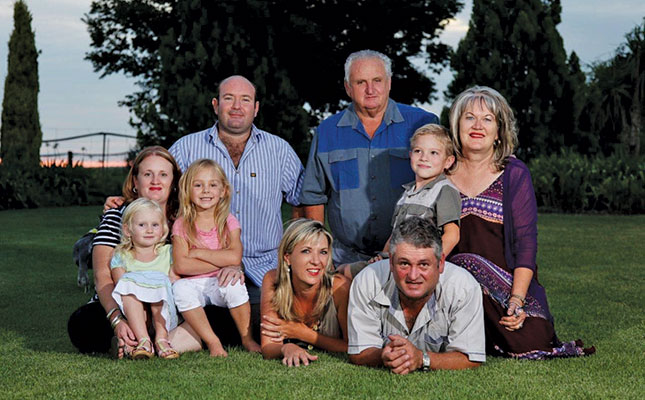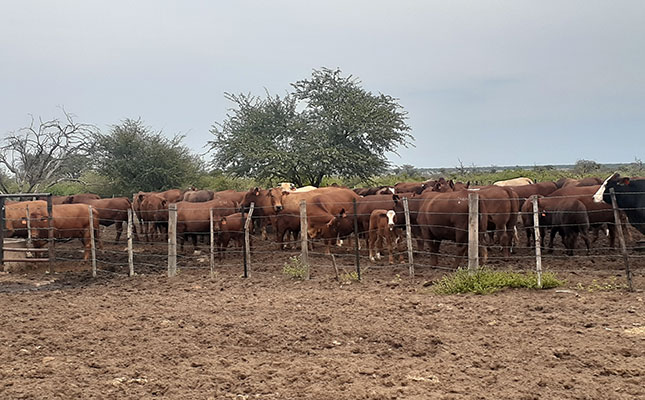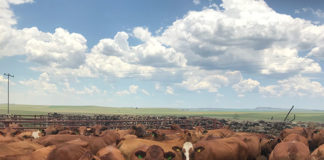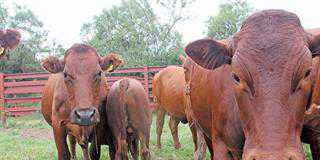
Photo: Snadri Photography
Petana Beefmasters is managed by Peet Koekemoer, his son Petie and son-in-law Connie Jansen van Vuuren. They run a mixed farming business that includes the Petana Stud, commercial sheep and cattle, as well as maize production.
The stud cattle concern, based near Wolmaransstad, North West, is responsible for about 35% of the annual business turnover. “We breed animals with a definite phenotypical Beefmaster appearance based on 40% Bos taurus and 60% Bos indicus.
Corrective mating is what sets us apart. It’s essential for us to retain the Bos indicus factor in our cattle,” Peet explains.
The 300-strong stud is kept on 5 500ha veld and planted pastures. One third of the grazing consists of planted pastures, mainly Smuts finger. The land is situated in a grassland biome with a western highveld sandy grassland vegetation type.
The altitude of the farm varies between 1 280m and 1 520m, according to Connie. The landscape comprises flat to gently undulating plains with short, dry grassland and some woody species – Acacia karroo (Sweet thorn), Rhus lancea (Karee) and Acacia erioloba (Camel thorn).
The soils are sandy and weathered. Temperatures climb as high as 30°C in summer with frequent severe frost in winter.
Switching to Beefmasters
After trying a number of beef cattle breeds over the years, the team switched to Beefmasters in 2002. “None of the other breeds performed as well as the Beefmaster in our business set-up,” Peet states, adding that their animals are bred under extensive conditions.
“They are not pampered and have to perform optimally on the veld. The commercial beef producer is our main client and our responsibility is to enable our clients to produce the maximum kilograms per ha.
That’s why our breeding philosophy is based on the six principles of Tom Lasater, the father of the Beefmaster breed: fertility, hardiness, weight, milk production, adaptability and temperament.”
The animals perform equally well in the sandy soils of the Kalahari and the rest of South Africa. “Our bulls are fit and muscular, with sufficient depth, length and width,” explains Peet.
“We pride ourselves on the fact that we produce work-ready bulls that function optimally under most conditions, even the Northern Cape’s dunes deep in the Kalahari. I actually make the bulls run around to improve their fitness levels. There’s simply no place for an overfed, lazy bull in our business,” says Peet.
The stud officially came into being in 2001. The first Beefmaster bulls were purchased from Kerneels van Rensburg’s Nooitgedacht Stud in Ermelo.
Peet, Petie and Connie then proceeded to select dams from their existing Brahman- and Simmentaler-based herd. This was followed by the purchase of eight registered bulls and 12 cows from the Northern Transvaal Beefmaster club from breeders Mike Bosch, Jan Schoeman and Hardus Steenkamp.
Strong genetic base
According to Peet, the quality and growth of the first calves validated their decision to breed Beefmasters. Over the years, the stud was augmented by animals from WO Beefmasters (Vrede), Bos Blanco (Kroonstad), Beefmaster Alliance (Delmas), Pierre Hart (Komga) and Pieter van Deventer (Lichtenburg).
Connie explains that they made sure to build up a strong genetic base from the beginning.
“We’d rather buy an average bull from a successful breeder with a proven track record than a top bull from a run of the mill herd.
We select very strictly for form and functionality, and only the top 10% of the bulls, on average, make it to our production sale. The Petana bulls are medium-framed, well-balanced and have strong walking ability. We also select for strong jaws and lips that enable the animals to make optimal use of grazing.”
As they farm under extensive conditions, they breed animals that are well-adapted to the challenging conditions.
“The selected animals are marketed through the annual Petana production auction, the National Beefmaster sale and the North West Beefmaster club auctions. The next sale is on 13 August.”
Peet says a long, strong tail is of the essence. Unlike shorter-tailed animals, cows with long tails use less energy to manage flies and other insects, and consequently spend more time grazing.
The team also insist exceptional depth in all the animals. Slack-loined cows without depth are culled without exception. A flank line that continues too high is a clear indication of a lack of depth, according to Peet.
About 25% are artificially inseminated (AI) annually. “We inseminate according to the prospective dams’ natural cycles. It is infinitely healthier for the animals than artificial synchronisation.
The selected animals are kraaled about 65 days after calving. The calves are separated from the dams in the evenings and we use teaser bulls to determine the cows’ heat status,” he explains.
“Not only is this system much more user-friendly, it is also markedly cheaper than the artificial process. We’ve lost cows to the artificial process in the past.”
According to Peet, genetic variation is key to the success of their operation. “We use only the best genetics on the market for our AI programme. For that, we need genetics from national and international gene pools,” he says.
Breeding seasons
The team implemented two single sire breeding seasons. Bulls are kept with the cows for 90 days during the summer season and 60 days in winter at a ratio of one bull per 20 cows.
The average birth weight is 33kg, with a mean weaner weight of 232kg at about seven months for all calves. The inter-calf period is 412 days, but the goal is to shorten it to 365 days.
The animals are kept in camps in a wagon- wheel system centred on a watering point – four camps around each of the 20 watering points. The 25ha to 30ha camps are grazed rotationally.
The cattle are vaccinated against local diseases such as lumpy skin and anaplasmosis. Bulls are tested for fertility, CA and TB and sheath-washed for trichomoniasis and vibriosis, and certified by a vet before they are put on the market.
“The Beefmaster is currently the third-largest beef cattle breed in South Africa, with an average herd size of 250 animals,” says Connie, who is vice-president of the SA Beefmaster Breeders’ Society.
“This is probably the easiest breed to start a stud with. For instance, the first calf of a Brahman type cow mated with a Beefmaster qualified as an Appendix A animal. Through mating with Beefmaster bulls, the calf’s progeny can be bred up with the third generation, eventually qualifying as Beefmaster.”
He explains that until recently, they had to deal with the perception that the Beefmaster was bred exclusively for the feedlot industry.
“This is not true. The breed is increasingly becoming known as a hardy, well-adapted breed that performs exceptionally well under all farming conditions.”
Phone Peet Koekemoer on 082 773 7389, Connie Jansen van Vuuren on 082 373 4833 or Petie Koekemoer on 082 773 7390.













